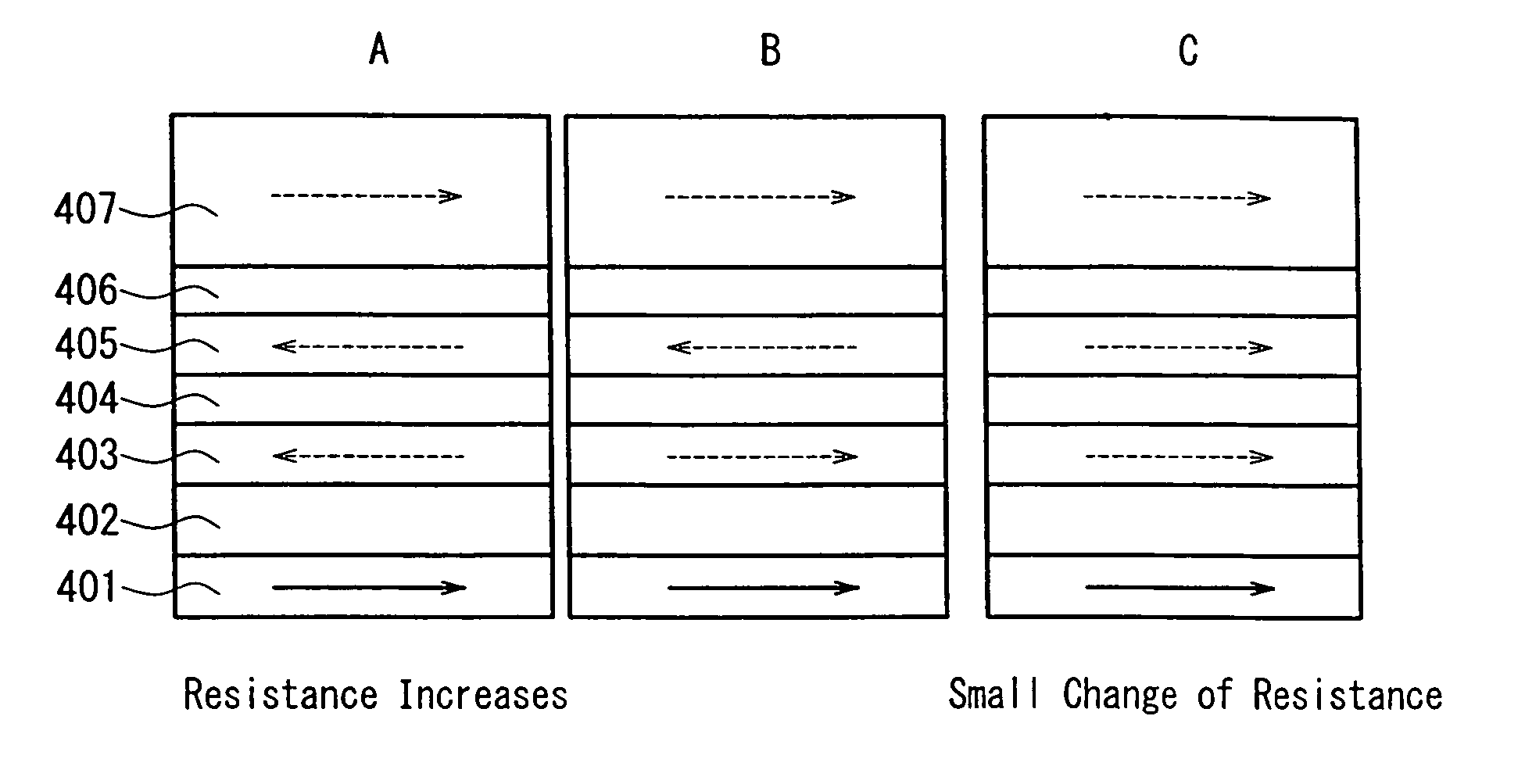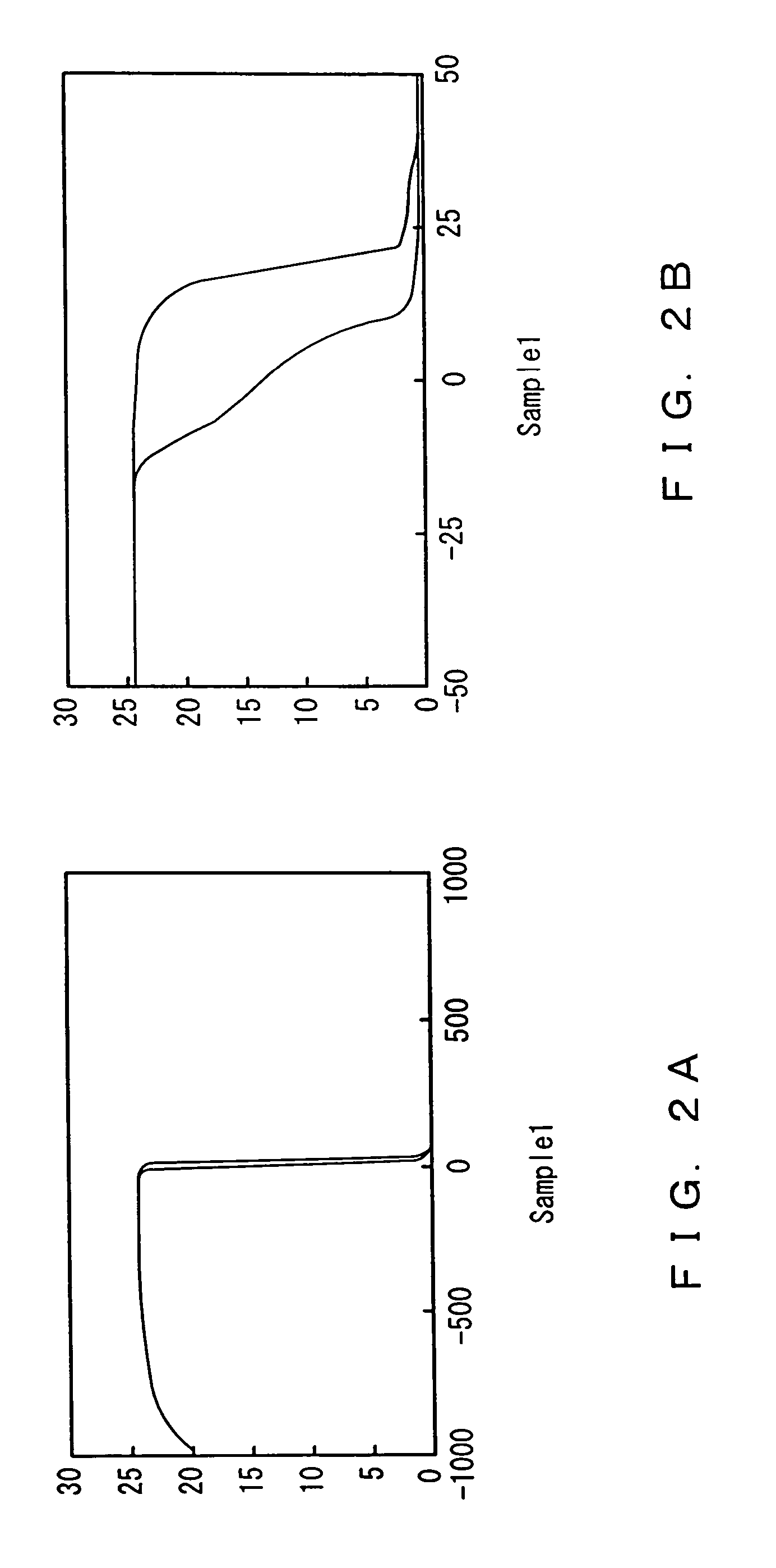Magneto-resistive element
a magneto-resistive element and element technology, applied in the field of magneto-resistive elements, can solve the problems of increasing the reversal magnetic field, reducing the reproduction sensitivity brought about by an increase in coercivity, and affecting the reproduction sensitivity, so as to achieve the effect of suppressing the demagnetizing field
- Summary
- Abstract
- Description
- Claims
- Application Information
AI Technical Summary
Benefits of technology
Problems solved by technology
Method used
Image
Examples
working example 1
[0122]The following MR elements were produced by magnetron sputtering on a thermally oxidized Si substrate. The general configuration of these elements is shown in FIG. 1.
Sample 1
[0123]Ta(3) / Cu(500) / Ta(3) / PtMn(30) / CoFe(3) / Ru(0.7) / CoFe(3) / Al2O3(1) / NiFe(8) / Ta(3)
Sample 2
[0124]Ta(3) / Cu(500) / Ta(3) / PtMn(30) / CoFe(3) / Ru(0.7) / CoFe(3) / Al2O3(1) / NiFe(4) / Ta(3) / NiFe(4) / Ta(3)
Sample 3
[0125]Ta(3) / Cu(500) / Ta(3) / PtMn(30) / CoFe(3) / Ru(0.7) / CoFe(3) / Al2O3(1) / NiFe(5) / Ru(0.7) / NiFe(3) / Ta(3)
[0126](The numbers in parentheses indicate the film thicknesses in nm. The film configuration is noted starting at the substrate side. This is also true in the following.)
[0127]Here, Ta(3) / Cu(500) / Ta(3) serves as a lower electrode and primer layer 103 on a substrate 104, PtMn is an antiferromagnetic layer (not shown), CoFe(3) / Ru(0.7) / CoFe(3) is a pinned magnetic layer 107, Al2O3 is the intermediate layer 106, and the rest serves as the free magnetic layer 105 (and the last layer Ta(3) as the protective layer).
[0128]The para...
working example 2
[0151]The following elements were produced by magnetron sputtering on a thermally oxidized Si substrate.
Sample 1
[0152]Ta(3) / Cu(500) / Ta(3) / CoFe(32) / Al2O3(X) / CoFe(3) / Ru(0.7) / CoFe(3) / PtMn(20) / Ta(3)
Sample 2
[0153]Ta(3) / Cu(500) / Ta(3) / (CoFe(4) / Ta(3) / CoFe(4))*4 / Al2O3(X) / Fe(3) / Ru(0.7) / CoFe(3) / PtMn(20) / Ta(3)
Sample 3
[0154]Ta(3) / Cu(500) / Ta(3) / (CoFe(3) / Ru(0.7) / CoFe(5))*4 / Al2O3(X) / CoFe(3) / Ru(0.7) / CoFe(3) / PtMn(20) / Ta(3)
[0155]Here, (CoFe(4) / Ta(3) / CoFe(4))*4 means that the layers (CoFe(4) / Ta(3) / CoFe(4)) are produced four times in repetition.
[0156]The multilayer films were microprocessed using photolithography into mesa shapes with an element area of 2×5, 10×25, 20×50, and 40×100 μm2, and after forming an inter-layer insulator film, an upper electrode was formed, yielding vertical current-type magneto-resistive elements with the cross section shown in FIG. 7 and FIG. 8. In these elements, the free magnetic layer 105 is arranged on the substrate side, different from FIG. 1. The film thickness X of the...
working example 3
[0160]The following sample was produced by magnetron sputtering on a thermally oxidized Si substrate.
[0161]Ta(3) / Cu(500) / Ta(3) / PtMn(30) / CoFe(3) / Ru(0.7) / CoFe(3) / Al2O3(1.5) / CoFe(d1) / Ru(0.7) / NiFe(d2) / Ta(3)
[0162]Multilayer films with this configuration were microprocessed using photolithography into mesa shapes with an element area of 2×2 μm, and after forming an inter-layer insulator film, an upper electrode was formed, yielding a vertical current-type magneto-resistive element with the cross section shown in FIG. 1. The parameters for the thermal processing were a temperature of 260° C., a magnetic field of 5 kOe, and a time of 1.5 h. Then, the MR when applying magnetic fields of ±200 Oe to the resulting element was measured, and the change of the MR in a relatively small external magnetic field was examined. The results are shown in Table 2. With the saturation magnetization M1 of CoFe being 2.15 T and the saturation magnetization M2 of NiFe being 1 T, CoFe has the higher spin polari...
PUM
| Property | Measurement | Unit |
|---|---|---|
| area | aaaaa | aaaaa |
| thickness | aaaaa | aaaaa |
| thickness | aaaaa | aaaaa |
Abstract
Description
Claims
Application Information
 Login to View More
Login to View More - R&D
- Intellectual Property
- Life Sciences
- Materials
- Tech Scout
- Unparalleled Data Quality
- Higher Quality Content
- 60% Fewer Hallucinations
Browse by: Latest US Patents, China's latest patents, Technical Efficacy Thesaurus, Application Domain, Technology Topic, Popular Technical Reports.
© 2025 PatSnap. All rights reserved.Legal|Privacy policy|Modern Slavery Act Transparency Statement|Sitemap|About US| Contact US: help@patsnap.com



